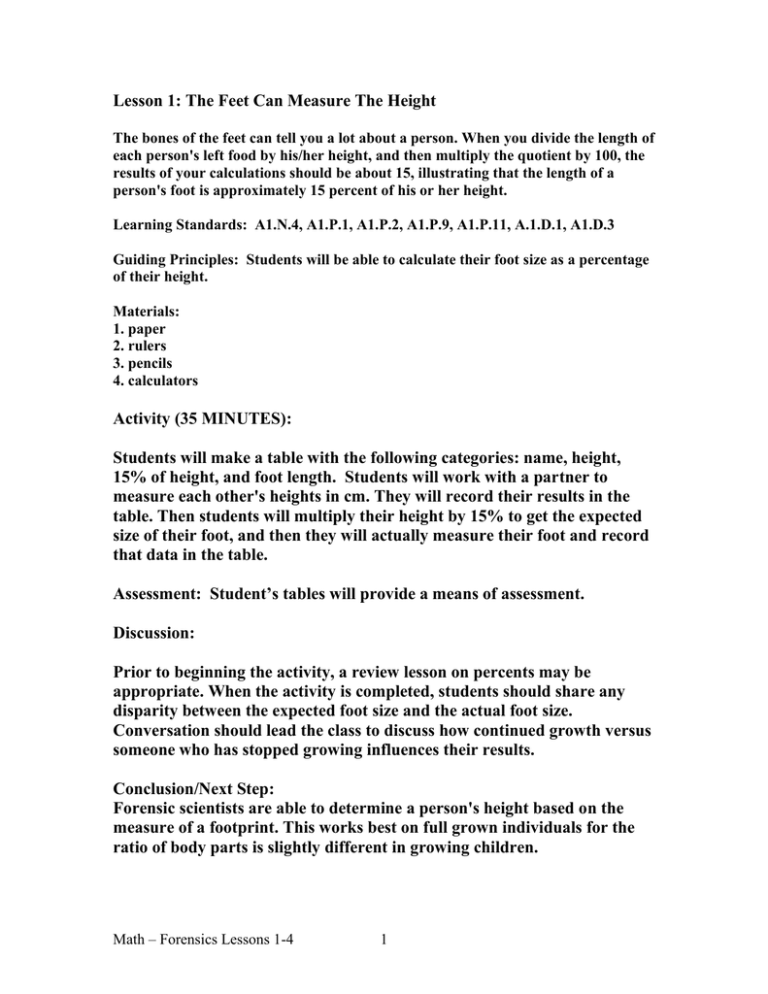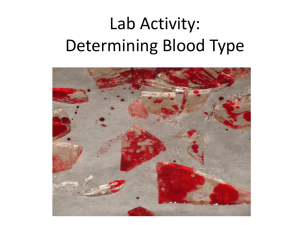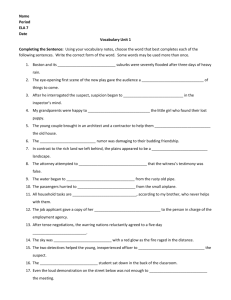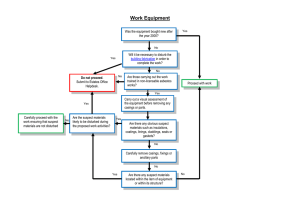AttleboroMathForensics
advertisement

Lesson 1: The Feet Can Measure The Height The bones of the feet can tell you a lot about a person. When you divide the length of each person's left food by his/her height, and then multiply the quotient by 100, the results of your calculations should be about 15, illustrating that the length of a person's foot is approximately 15 percent of his or her height. Learning Standards: A1.N.4, A1.P.1, A1.P.2, A1.P.9, A1.P.11, A.1.D.1, A1.D.3 Guiding Principles: Students will be able to calculate their foot size as a percentage of their height. Materials: 1. paper 2. rulers 3. pencils 4. calculators Activity (35 MINUTES): Students will make a table with the following categories: name, height, 15% of height, and foot length. Students will work with a partner to measure each other's heights in cm. They will record their results in the table. Then students will multiply their height by 15% to get the expected size of their foot, and then they will actually measure their foot and record that data in the table. Assessment: Student’s tables will provide a means of assessment. Discussion: Prior to beginning the activity, a review lesson on percents may be appropriate. When the activity is completed, students should share any disparity between the expected foot size and the actual foot size. Conversation should lead the class to discuss how continued growth versus someone who has stopped growing influences their results. Conclusion/Next Step: Forensic scientists are able to determine a person's height based on the measure of a footprint. This works best on full grown individuals for the ratio of body parts is slightly different in growing children. Math – Forensics Lessons 1-4 1 Lesson 2: Determine The Foot Size of The Four Suspects At approximately 7 15am, Friday morning, Mrs. King, the seventh grade science teacher, thought something was fishy as she walked down the hall and noticed that her door was open. She walked into her classroom and immediately discovered that the small aquarium had been broken and her prized gold fish were gasping in the sink. Beside the broken aquarium were the shattered remains of the pinky piggy bank that had been on the shelf above the aquarium. A can of blue paint was spilled on the floor. Footprints of a barefooted burglar led to an open window. Bits of a white powdery substance were found next to the broken, empty, piggy bank. The only other item found was a half eaten large chunk of chocolate candy. When the police arrived they immediately began to gather the following evidence: 1. sticky fingerprints were lifted from the aquarium and piggy bank 2. the painted footprints were measured; the footprint measured 10.5 inches 3. the chunk of chocolate candy was collected for examination; it appeared there were teeth imprints 4. the white powdery substance by the piggy bank was carefully placed in a plastic bag and taken to the forensic chemist for identification Police found four suspects to the crime. Their names and information is as follows: 1. Lou Lou is 5'3'' 2. Dan the Man is 5'10'' 3. Peg the Leg is 5' 4. Jake the Jock is 6'6'' Learning Standards: A1.N.4, A1.P.1, A1.P.2, A1.P.9, A1.P.11, A1.D.1, A1.D.3 Guiding Principles: Students will be able to identify the prime suspect in the crime based on calculating each suspect’s foot size as a percentage of their heights. Materials: 1. paper 2. rulers 3. pencils 4. calculators Activity (35 minutes): Students will put each of the four suspects information on the board. Students will convert each suspect's height to inches and then calculate each suspect's foot size based on their height (multiply by 15%). Students may then discuss which of the suspects match the footprint found at the scene of the crime. Recall that the footprint at the scene of the crime measured 10.5 inches. From there, students should convert the data they calculated from inches to centimeters. A review lesson on proportions may Math – Forensics Lessons 1-4 2 be appropriate. For example, to calculate Peg the Leg's height in centimeters: 30 cm x ____ _ = _____ 12 in 60 in Student's should do this for each of the suspect's height as well as foot size so all the data is in terms of centimeters, as they were measured in the first lesson. Students should organize this data in a small table or chart. Assessment: Student’s chart will provide a means of assessment. Conclusion/Next Step: Students should be able to identify the suspect who committed the crime based on their analysis of the data. A conversation could ensure about other potential suspects given particular data at hand. Lesson 3: Suspect's Data To Teach Statistics Now that all the data on the suspects has been calculated, its time to put that data to use. The statistics reviewed for this lesson are mean, median, mode, and range. Learning Standards: A1.N.4, A1.P.1, A1.P.2, A1.P.9, A1.P.11, A1.D.1, A1.D.3, Guiding Principles: Students will be able to look at the suspect’s data in terms of the algebraic statistics presented. Materials: 1. paper 2. pencils 3. calculators Activity (35 minutes): Students will put each of the four suspect's information on the board. The suspect's height and foot size should be presented in centimeters: Lou Lou -height: 157.5 cm -foot size: 23.63 cm Math – Forensics Lessons 1-4 Peg the Leg -height: 150 cm -foot size: 22.5 cm 3 Dan the Man -height: 175 cm -foot size: 26.25 cm Jake the Jock -height: 195 cm -foot size: 29.25 cm A review of the following statistics should be discussed: mean, median, mode, and range. Students should discuss definitions for each of these statistics and put them on the board and in their notes: mean: the average median: the middle number after the data set has been put in numerical order mode: the data that appears most frequently range: the difference between the largest and smallest data Starting with height of the four suspects, students should calculate the four statistics. After a review and discussion of those results, students should do the same for the suspect's foot size. For height: mean: 169.38 median: 166.25 mode: no mode range: 45 For foot size: mean: 25.41 median: 24.94 mode: no mode range: 6.75 Assessment: Student’s analysis of the suspect’s data should be organized in a spreadsheet, matrix, or a simple table. Conclusion/Next Step: there’s potential for an extension to this lesson, or a fourth lesson for this module: Lesson 4: Suspect's Data To Teach Graphing (Optional) Now that all the data on the suspects has been calculated, its time to put that data to use. Materials: 1. paper 2. pencils 3. calculators Math – Forensics Lessons 1-4 4 Activity: Students will put each of the four suspect's information on the board. The suspect's height and foot size should be presented in centimeters: Lou Lou -height: 157.5 cm -foot size: 23.63 cm Peg the Leg -height: 150 cm -foot size: 22.5 cm Dan the Man -height: 175 cm -foot size: 26.25 cm Jake the Jock -height: 195 cm -foot size: 29.25 cm The suspect's data will be graphed on the coordinate plane. Students should discuss the independent vs. dependant axes and determine which data should go on which axis. Students should set up their axes then plot the coordinates. From there, conversations regarding slope, line of best fit, distance, and midpoint could be pursued. Math – Forensics Lessons 1-4 5





